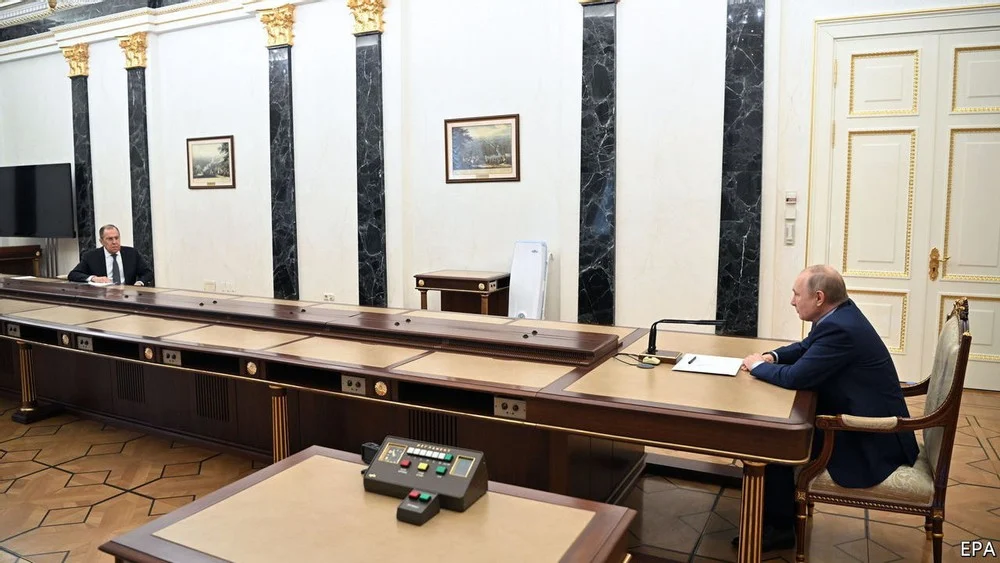•Russia offers an olive branch, but still wields the sword
•Vladimir Putin signals a readiness to keep negotiating with the West, amid mixed signals on Russia’s military build-up
By The Economist
Has Russia just blinked? Or is it just closing an eye the better to aim and squeeze the trigger? After weeks of relentless military build-up by Russian forces around Ukraine, and Western threats to impose unprecedented economic pain if they invade, a choreographed scene from the Kremlin has caught the attention of Western capitals.
Sitting at the end of an interminably long table, of the sort that has become de rigueur for Vladimir Putin’s diplomacy, the Russian president summoned his underlings to report on their progress. The foreign minister, Sergei Lavrov, declared that the West’s response to Russia’s demands was disappointing, at times even insulting. But it had been shaken by Russia’s actions, Mr Lavrov noted, and America, in particular, had responded positively to at least some demands, notably over arms control in Europe. Talks could not drag on, but he “recommended” intensifying diplomatic contacts. “It seems to me that our possibilities are far from exhausted,” he declared, to approval from Mr Putin. Shortly thereafter Sergei Shoigu, the defence minister, said that some of Russia’s military exercises had ended and others were close to completion.
Meanwhile in Kyiv, Ukraine’s capital, there was another sign of possible diplomatic movement. Olaf Scholz, the German chancellor, said that Ukraine’s membership of NATO was in practice off the table. Standing next to him Volodymyr Zelensky, Ukraine’s president, said that joining the military alliance, though enshrined in the constitution, was “a dream”. In other words, neither man would bow to Russia’s demand for a formal guarantee that Ukraine would never join NATO. But they were more explicit than in the past in declaring that it would not happen for a long time, if ever. Whether this moves Mr Putin may become apparent when Mr Scholz visits Moscow, a week after a similar diplomatic round by President Emmanuel Macron of France. In a telephone call, President Joe Biden and the British prime minister, Boris Johnson, said there remained “a crucial window” for diplomacy.
Taken together, these signals suggest it is possible to avert a looming war—should Mr Putin choose to do so. America, which has been warning that a Russian invasion could be imminent, cautiously welcomed Mr Lavrov’s comments. They matched signals he had made in private to America’s secretary of state, Antony Blinken, said the State Department. But no new meetings had been set. To be credible, said Ned Price, the spokesman, Russia’s diplomatic feelers would have to be accompanied by “de-escalation”, of which there was still no sign.
Indeed, Mr Putin is continuing to add to his forces around Ukraine, Western officials say. “He continues to do the things that you would expect one to do if one was planning on a major military action and that is to sharpen the readiness and to add to the capabilities of his force,” said John Kirby, the Pentagon spokesman. The American embassy in Kyiv is closing, and staff are relocating to the western Ukrainian city of Lviv.
Western officials talk of 14 more Russian battalion tactical groups being sent to join the 100-odd already deployed around Ukraine. They include Spetsnaz special forces and Iskander missile batteries. In the Black Sea, a Russian fleet is gathering strength, and would be able both to deploy an amphibious landing force and launch “precision fires”. The order of battle suggests a thrust from Belarus to threaten Kyiv, and an effort to encircle Ukraine’s best troops, currently deployed in the east of the country against separatist militias that control two enclaves, around the cities of Donetsk and Luhansk.
In response, NATO has been sending modest forces to reassure allies in central and eastern Europe—thousands of troops in contrast with the estimated 130,000 that Russia has deployed. On February 14th hundreds of German soldiers began arriving to reinforce their presence in Lithuania, and eight more American fighter jets landed in Poland. NATO defence ministers are scheduled to discuss the crisis in Brussels on February 16th and 17th.
As well as its more emollient signals Russia has also issued warnings against “provocation” by Ukraine, supposedly encouraged by Western threats and military deployments. On February 15th, the Duma, Russia’s lower house of parliament, voted to recognise the breakaway regions of Ukraine, a step short of outright annexation; the proposal would be sent to Mr Putin “immediately”. Some officials in Russia suggest this might be a way out of the current crisis.
In short, Mr Putin appears to be keeping all options open. He could invade Ukraine “at the drop of a hat”, say Western officials. He could keep troops deployed for an extended period as a form of armed diplomacy. And with his diplomatic overtures, he has also given himself the means of turning away from war if he deems conditions unfavourable, or thinks he has gained enough without having to take more risks. After all, Russia has always claimed to have no plan to invade Ukraine.
“I like to think the Russians have blinked,” says William Taylor, a former American ambassador in Ukraine now at the United States Institute of Peace, a think-tank. “Perhaps they have examined the costs and benefits and seen that the costs are really high. But even if Mr Putin de-escalates, it will not be for ever. For as long as he’s alive he will try and try to dominate Ukraine.”
Credit | The Economist

